Analyzing Workplace Dynamics: An Article Review on Collaboration
VerifiedAdded on 2023/06/12
|11
|2607
|127
Literature Review
AI Summary
This assignment provides a comprehensive review of an article discussing the critical role of workplace collaboration in modern business environments. It highlights the increasing importance of teamwork due to globalization and heightened competition. The review delves into key questions about leadership's role in fostering collaboration, the types of collaborations adopted by companies, and the equitable distribution of tasks among employees. It explores the behavioral science aspects of collaboration, including the impact of motivation, pressure, and information sharing on employee performance. The review also examines the influence of technology and structural changes on workplace collaboration, emphasizing the importance of knowledge transfer and maintaining a balance between individual employee needs and organizational goals. The document is available on Desklib, a platform offering a range of study tools and solved assignments for students.
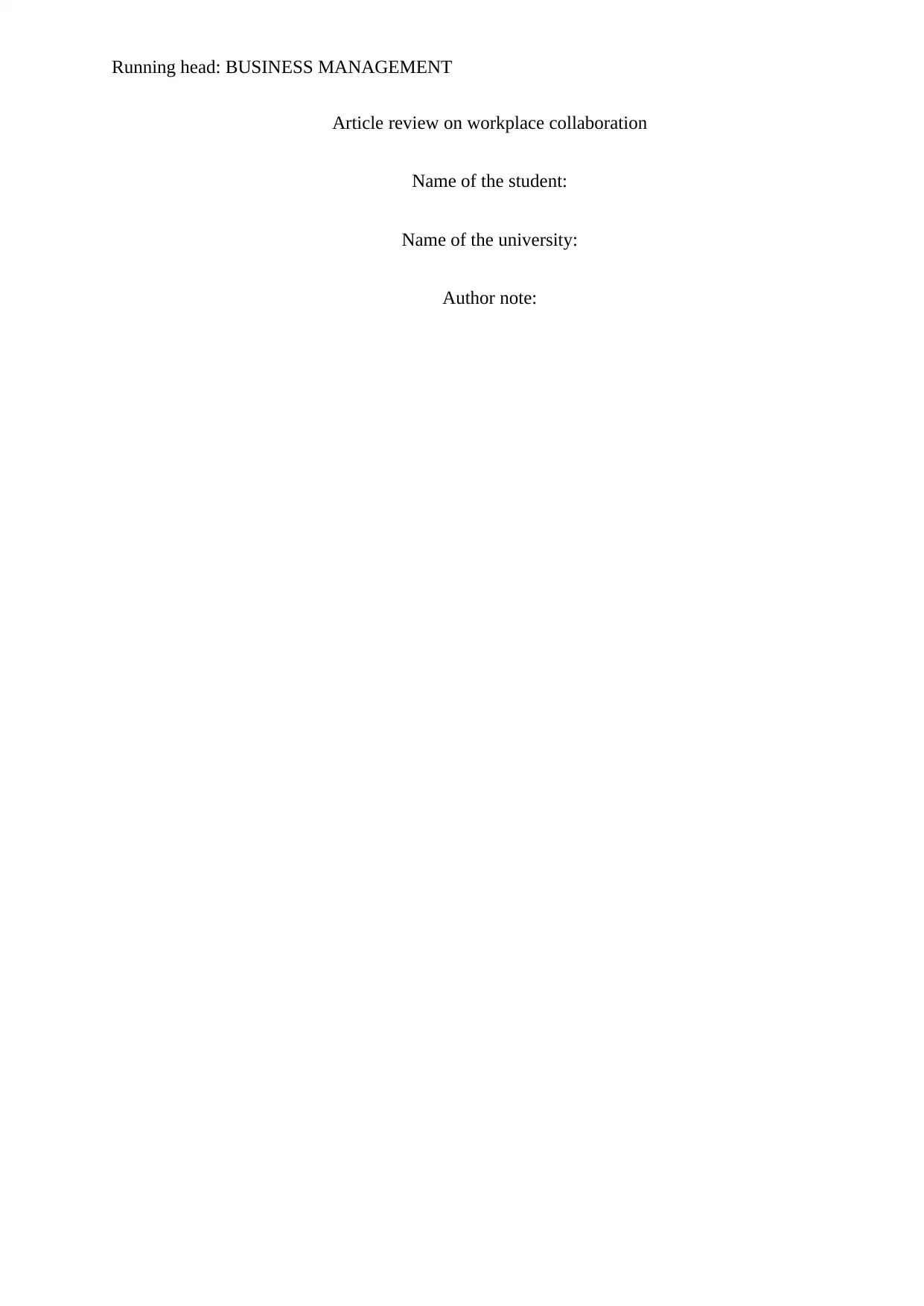
Running head: BUSINESS MANAGEMENT
Article review on workplace collaboration
Name of the student:
Name of the university:
Author note:
Article review on workplace collaboration
Name of the student:
Name of the university:
Author note:
Paraphrase This Document
Need a fresh take? Get an instant paraphrase of this document with our AI Paraphraser
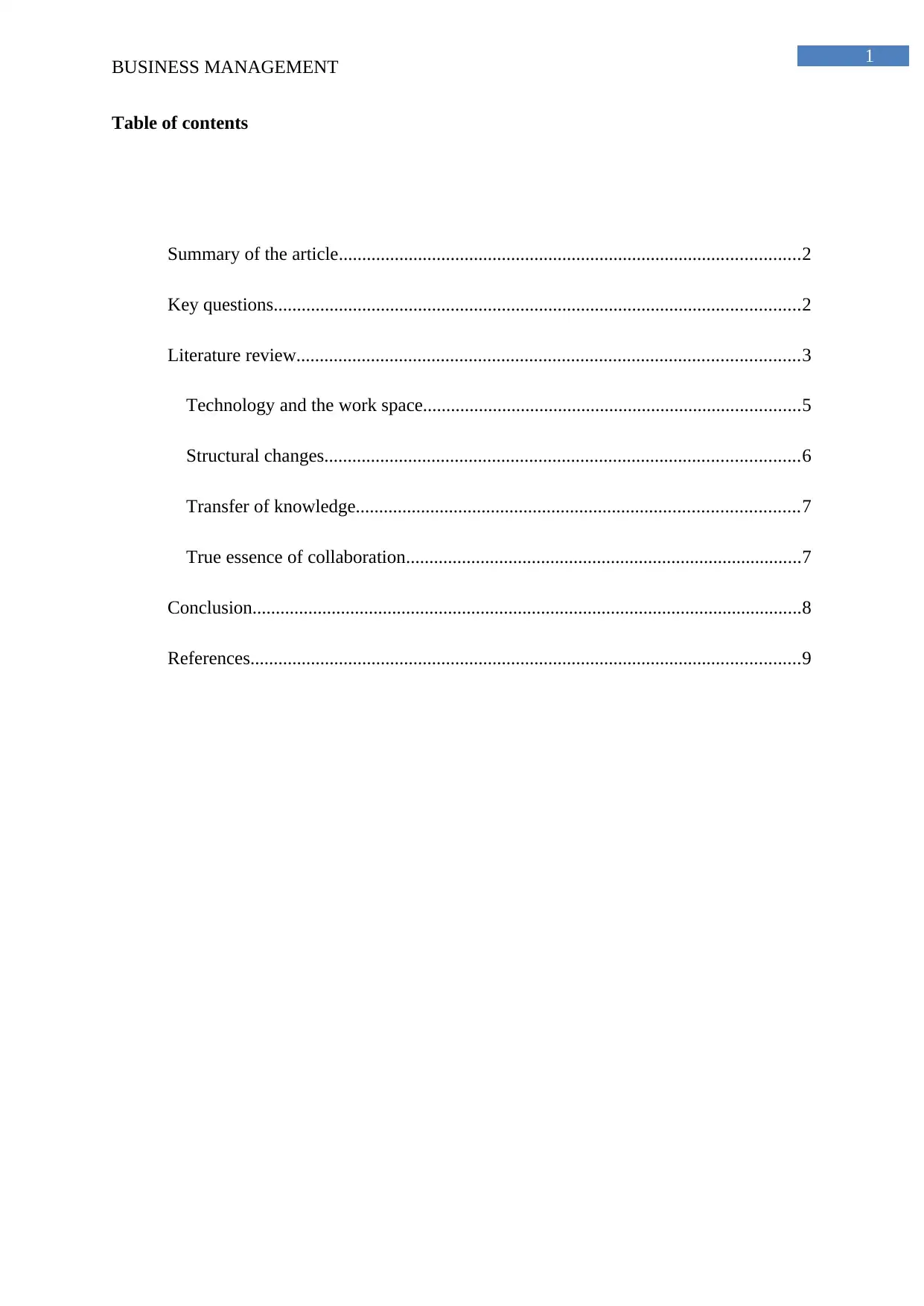
1
BUSINESS MANAGEMENT
Table of contents
Summary of the article...................................................................................................2
Key questions.................................................................................................................2
Literature review............................................................................................................3
Technology and the work space.................................................................................5
Structural changes......................................................................................................6
Transfer of knowledge...............................................................................................7
True essence of collaboration.....................................................................................7
Conclusion......................................................................................................................8
References......................................................................................................................9
BUSINESS MANAGEMENT
Table of contents
Summary of the article...................................................................................................2
Key questions.................................................................................................................2
Literature review............................................................................................................3
Technology and the work space.................................................................................5
Structural changes......................................................................................................6
Transfer of knowledge...............................................................................................7
True essence of collaboration.....................................................................................7
Conclusion......................................................................................................................8
References......................................................................................................................9
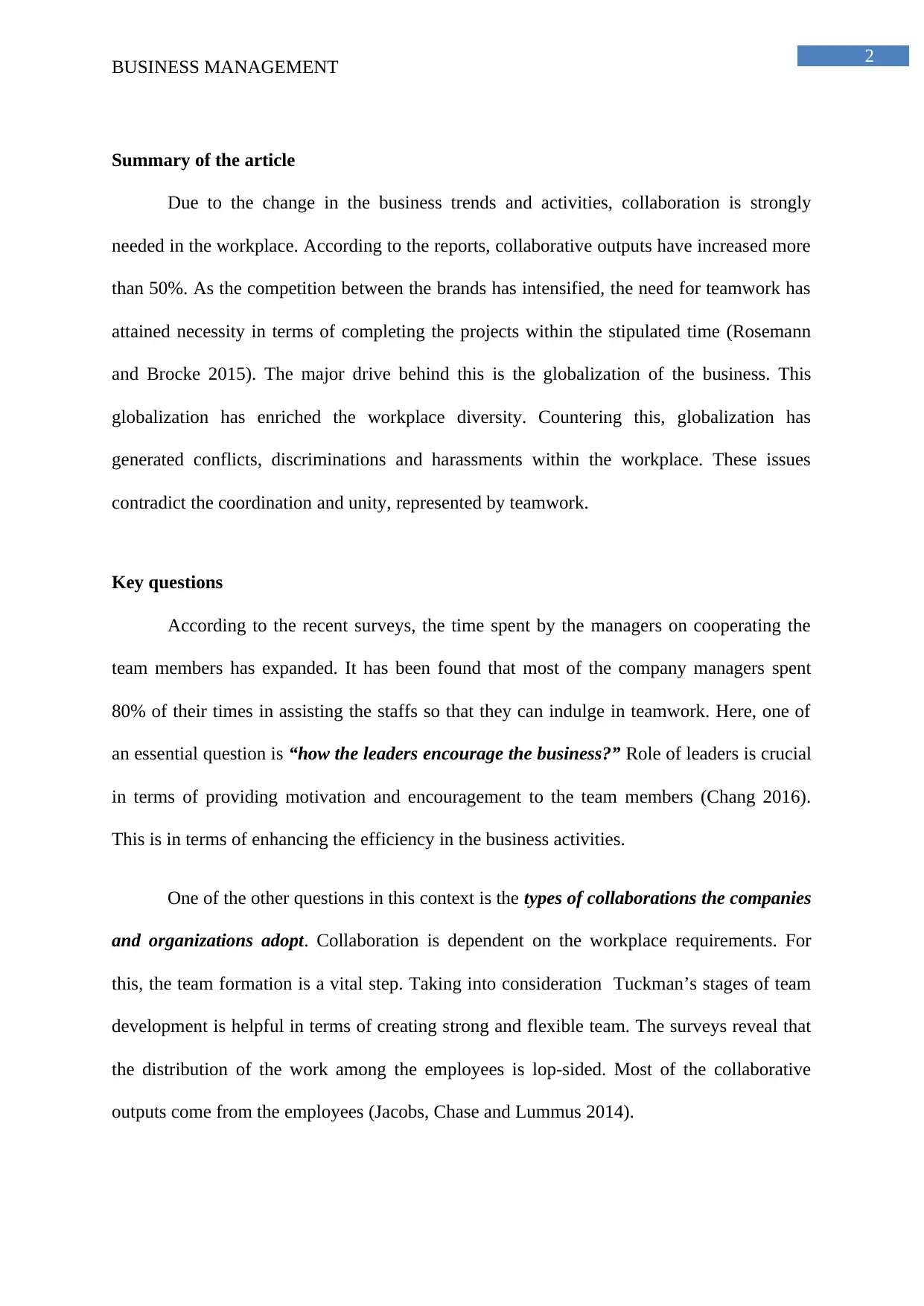
2
BUSINESS MANAGEMENT
Summary of the article
Due to the change in the business trends and activities, collaboration is strongly
needed in the workplace. According to the reports, collaborative outputs have increased more
than 50%. As the competition between the brands has intensified, the need for teamwork has
attained necessity in terms of completing the projects within the stipulated time (Rosemann
and Brocke 2015). The major drive behind this is the globalization of the business. This
globalization has enriched the workplace diversity. Countering this, globalization has
generated conflicts, discriminations and harassments within the workplace. These issues
contradict the coordination and unity, represented by teamwork.
Key questions
According to the recent surveys, the time spent by the managers on cooperating the
team members has expanded. It has been found that most of the company managers spent
80% of their times in assisting the staffs so that they can indulge in teamwork. Here, one of
an essential question is “how the leaders encourage the business?” Role of leaders is crucial
in terms of providing motivation and encouragement to the team members (Chang 2016).
This is in terms of enhancing the efficiency in the business activities.
One of the other questions in this context is the types of collaborations the companies
and organizations adopt. Collaboration is dependent on the workplace requirements. For
this, the team formation is a vital step. Taking into consideration Tuckman’s stages of team
development is helpful in terms of creating strong and flexible team. The surveys reveal that
the distribution of the work among the employees is lop-sided. Most of the collaborative
outputs come from the employees (Jacobs, Chase and Lummus 2014).
BUSINESS MANAGEMENT
Summary of the article
Due to the change in the business trends and activities, collaboration is strongly
needed in the workplace. According to the reports, collaborative outputs have increased more
than 50%. As the competition between the brands has intensified, the need for teamwork has
attained necessity in terms of completing the projects within the stipulated time (Rosemann
and Brocke 2015). The major drive behind this is the globalization of the business. This
globalization has enriched the workplace diversity. Countering this, globalization has
generated conflicts, discriminations and harassments within the workplace. These issues
contradict the coordination and unity, represented by teamwork.
Key questions
According to the recent surveys, the time spent by the managers on cooperating the
team members has expanded. It has been found that most of the company managers spent
80% of their times in assisting the staffs so that they can indulge in teamwork. Here, one of
an essential question is “how the leaders encourage the business?” Role of leaders is crucial
in terms of providing motivation and encouragement to the team members (Chang 2016).
This is in terms of enhancing the efficiency in the business activities.
One of the other questions in this context is the types of collaborations the companies
and organizations adopt. Collaboration is dependent on the workplace requirements. For
this, the team formation is a vital step. Taking into consideration Tuckman’s stages of team
development is helpful in terms of creating strong and flexible team. The surveys reveal that
the distribution of the work among the employees is lop-sided. Most of the collaborative
outputs come from the employees (Jacobs, Chase and Lummus 2014).
⊘ This is a preview!⊘
Do you want full access?
Subscribe today to unlock all pages.

Trusted by 1+ million students worldwide
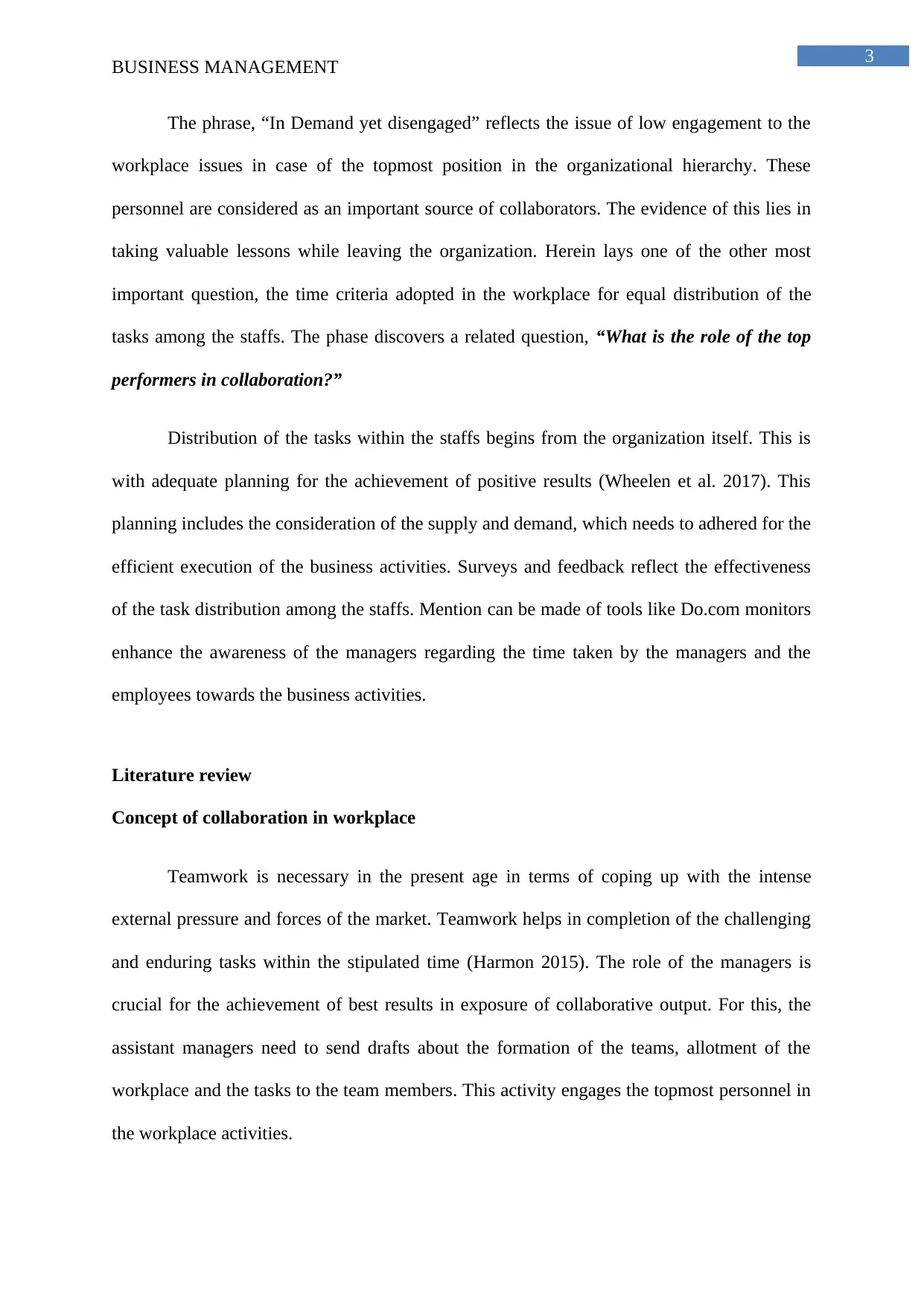
3
BUSINESS MANAGEMENT
The phrase, “In Demand yet disengaged” reflects the issue of low engagement to the
workplace issues in case of the topmost position in the organizational hierarchy. These
personnel are considered as an important source of collaborators. The evidence of this lies in
taking valuable lessons while leaving the organization. Herein lays one of the other most
important question, the time criteria adopted in the workplace for equal distribution of the
tasks among the staffs. The phase discovers a related question, “What is the role of the top
performers in collaboration?”
Distribution of the tasks within the staffs begins from the organization itself. This is
with adequate planning for the achievement of positive results (Wheelen et al. 2017). This
planning includes the consideration of the supply and demand, which needs to adhered for the
efficient execution of the business activities. Surveys and feedback reflect the effectiveness
of the task distribution among the staffs. Mention can be made of tools like Do.com monitors
enhance the awareness of the managers regarding the time taken by the managers and the
employees towards the business activities.
Literature review
Concept of collaboration in workplace
Teamwork is necessary in the present age in terms of coping up with the intense
external pressure and forces of the market. Teamwork helps in completion of the challenging
and enduring tasks within the stipulated time (Harmon 2015). The role of the managers is
crucial for the achievement of best results in exposure of collaborative output. For this, the
assistant managers need to send drafts about the formation of the teams, allotment of the
workplace and the tasks to the team members. This activity engages the topmost personnel in
the workplace activities.
BUSINESS MANAGEMENT
The phrase, “In Demand yet disengaged” reflects the issue of low engagement to the
workplace issues in case of the topmost position in the organizational hierarchy. These
personnel are considered as an important source of collaborators. The evidence of this lies in
taking valuable lessons while leaving the organization. Herein lays one of the other most
important question, the time criteria adopted in the workplace for equal distribution of the
tasks among the staffs. The phase discovers a related question, “What is the role of the top
performers in collaboration?”
Distribution of the tasks within the staffs begins from the organization itself. This is
with adequate planning for the achievement of positive results (Wheelen et al. 2017). This
planning includes the consideration of the supply and demand, which needs to adhered for the
efficient execution of the business activities. Surveys and feedback reflect the effectiveness
of the task distribution among the staffs. Mention can be made of tools like Do.com monitors
enhance the awareness of the managers regarding the time taken by the managers and the
employees towards the business activities.
Literature review
Concept of collaboration in workplace
Teamwork is necessary in the present age in terms of coping up with the intense
external pressure and forces of the market. Teamwork helps in completion of the challenging
and enduring tasks within the stipulated time (Harmon 2015). The role of the managers is
crucial for the achievement of best results in exposure of collaborative output. For this, the
assistant managers need to send drafts about the formation of the teams, allotment of the
workplace and the tasks to the team members. This activity engages the topmost personnel in
the workplace activities.
Paraphrase This Document
Need a fresh take? Get an instant paraphrase of this document with our AI Paraphraser
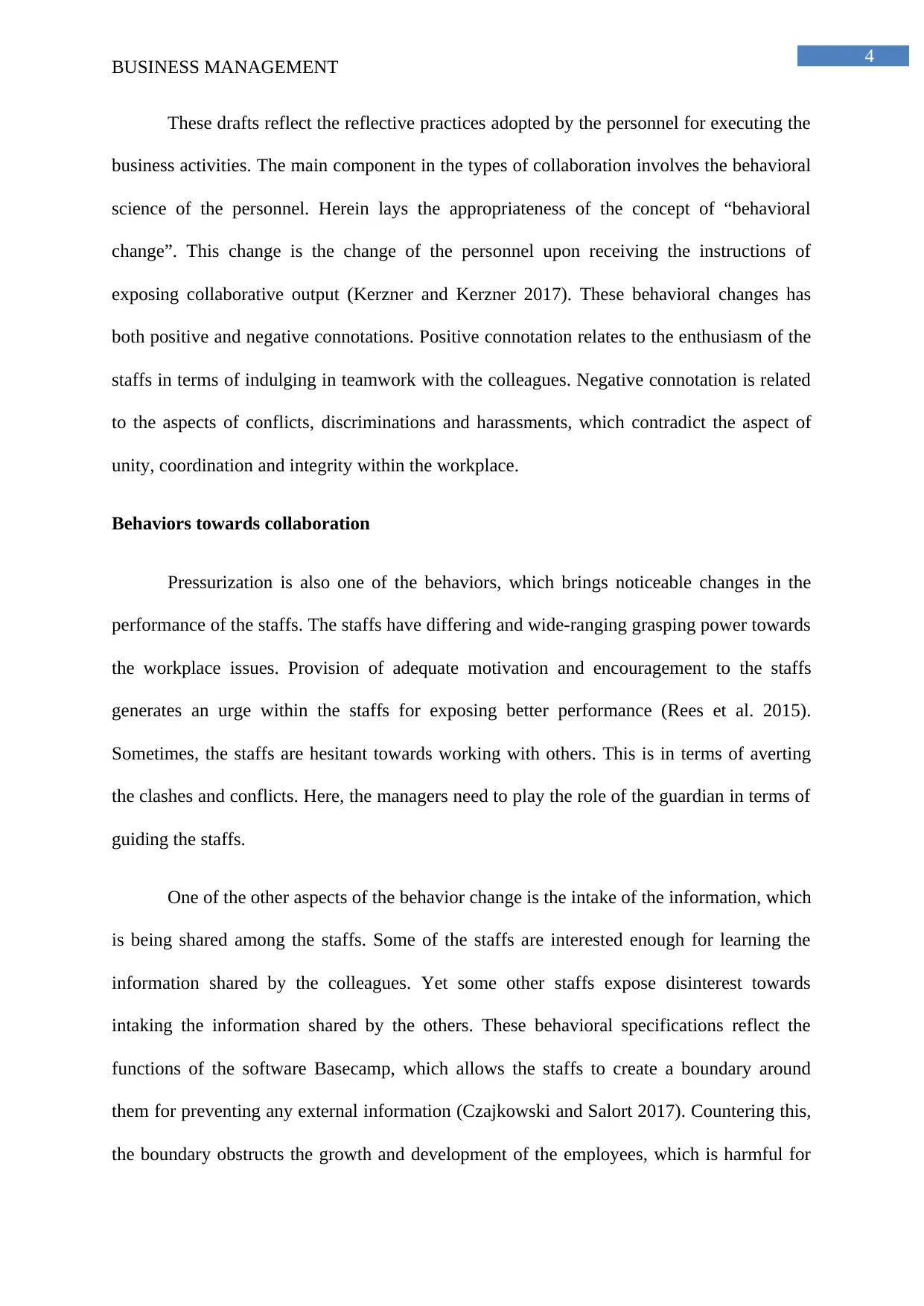
4
BUSINESS MANAGEMENT
These drafts reflect the reflective practices adopted by the personnel for executing the
business activities. The main component in the types of collaboration involves the behavioral
science of the personnel. Herein lays the appropriateness of the concept of “behavioral
change”. This change is the change of the personnel upon receiving the instructions of
exposing collaborative output (Kerzner and Kerzner 2017). These behavioral changes has
both positive and negative connotations. Positive connotation relates to the enthusiasm of the
staffs in terms of indulging in teamwork with the colleagues. Negative connotation is related
to the aspects of conflicts, discriminations and harassments, which contradict the aspect of
unity, coordination and integrity within the workplace.
Behaviors towards collaboration
Pressurization is also one of the behaviors, which brings noticeable changes in the
performance of the staffs. The staffs have differing and wide-ranging grasping power towards
the workplace issues. Provision of adequate motivation and encouragement to the staffs
generates an urge within the staffs for exposing better performance (Rees et al. 2015).
Sometimes, the staffs are hesitant towards working with others. This is in terms of averting
the clashes and conflicts. Here, the managers need to play the role of the guardian in terms of
guiding the staffs.
One of the other aspects of the behavior change is the intake of the information, which
is being shared among the staffs. Some of the staffs are interested enough for learning the
information shared by the colleagues. Yet some other staffs expose disinterest towards
intaking the information shared by the others. These behavioral specifications reflect the
functions of the software Basecamp, which allows the staffs to create a boundary around
them for preventing any external information (Czajkowski and Salort 2017). Countering this,
the boundary obstructs the growth and development of the employees, which is harmful for
BUSINESS MANAGEMENT
These drafts reflect the reflective practices adopted by the personnel for executing the
business activities. The main component in the types of collaboration involves the behavioral
science of the personnel. Herein lays the appropriateness of the concept of “behavioral
change”. This change is the change of the personnel upon receiving the instructions of
exposing collaborative output (Kerzner and Kerzner 2017). These behavioral changes has
both positive and negative connotations. Positive connotation relates to the enthusiasm of the
staffs in terms of indulging in teamwork with the colleagues. Negative connotation is related
to the aspects of conflicts, discriminations and harassments, which contradict the aspect of
unity, coordination and integrity within the workplace.
Behaviors towards collaboration
Pressurization is also one of the behaviors, which brings noticeable changes in the
performance of the staffs. The staffs have differing and wide-ranging grasping power towards
the workplace issues. Provision of adequate motivation and encouragement to the staffs
generates an urge within the staffs for exposing better performance (Rees et al. 2015).
Sometimes, the staffs are hesitant towards working with others. This is in terms of averting
the clashes and conflicts. Here, the managers need to play the role of the guardian in terms of
guiding the staffs.
One of the other aspects of the behavior change is the intake of the information, which
is being shared among the staffs. Some of the staffs are interested enough for learning the
information shared by the colleagues. Yet some other staffs expose disinterest towards
intaking the information shared by the others. These behavioral specifications reflect the
functions of the software Basecamp, which allows the staffs to create a boundary around
them for preventing any external information (Czajkowski and Salort 2017). Countering this,
the boundary obstructs the growth and development of the employees, which is harmful for
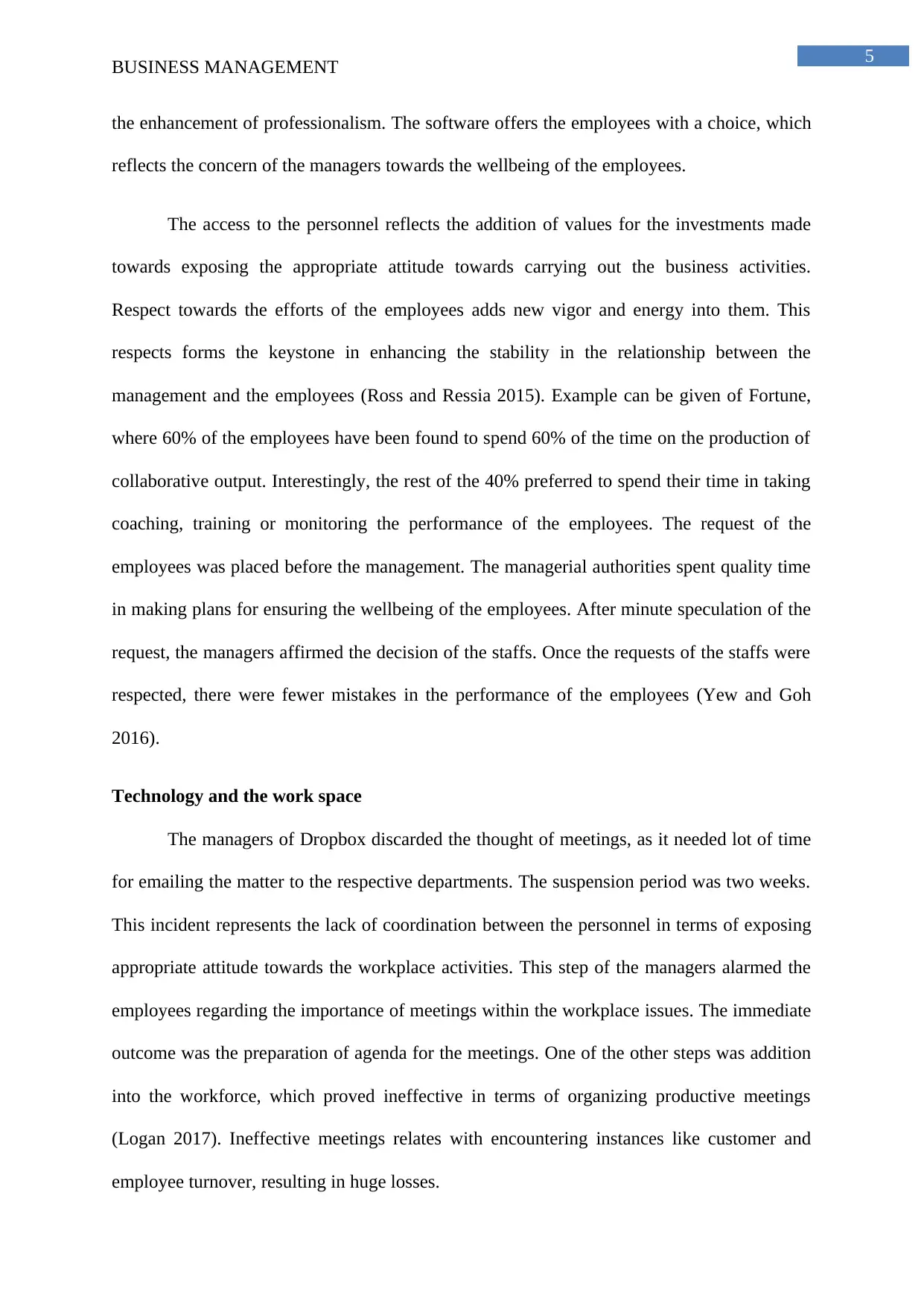
5
BUSINESS MANAGEMENT
the enhancement of professionalism. The software offers the employees with a choice, which
reflects the concern of the managers towards the wellbeing of the employees.
The access to the personnel reflects the addition of values for the investments made
towards exposing the appropriate attitude towards carrying out the business activities.
Respect towards the efforts of the employees adds new vigor and energy into them. This
respects forms the keystone in enhancing the stability in the relationship between the
management and the employees (Ross and Ressia 2015). Example can be given of Fortune,
where 60% of the employees have been found to spend 60% of the time on the production of
collaborative output. Interestingly, the rest of the 40% preferred to spend their time in taking
coaching, training or monitoring the performance of the employees. The request of the
employees was placed before the management. The managerial authorities spent quality time
in making plans for ensuring the wellbeing of the employees. After minute speculation of the
request, the managers affirmed the decision of the staffs. Once the requests of the staffs were
respected, there were fewer mistakes in the performance of the employees (Yew and Goh
2016).
Technology and the work space
The managers of Dropbox discarded the thought of meetings, as it needed lot of time
for emailing the matter to the respective departments. The suspension period was two weeks.
This incident represents the lack of coordination between the personnel in terms of exposing
appropriate attitude towards the workplace activities. This step of the managers alarmed the
employees regarding the importance of meetings within the workplace issues. The immediate
outcome was the preparation of agenda for the meetings. One of the other steps was addition
into the workforce, which proved ineffective in terms of organizing productive meetings
(Logan 2017). Ineffective meetings relates with encountering instances like customer and
employee turnover, resulting in huge losses.
BUSINESS MANAGEMENT
the enhancement of professionalism. The software offers the employees with a choice, which
reflects the concern of the managers towards the wellbeing of the employees.
The access to the personnel reflects the addition of values for the investments made
towards exposing the appropriate attitude towards carrying out the business activities.
Respect towards the efforts of the employees adds new vigor and energy into them. This
respects forms the keystone in enhancing the stability in the relationship between the
management and the employees (Ross and Ressia 2015). Example can be given of Fortune,
where 60% of the employees have been found to spend 60% of the time on the production of
collaborative output. Interestingly, the rest of the 40% preferred to spend their time in taking
coaching, training or monitoring the performance of the employees. The request of the
employees was placed before the management. The managerial authorities spent quality time
in making plans for ensuring the wellbeing of the employees. After minute speculation of the
request, the managers affirmed the decision of the staffs. Once the requests of the staffs were
respected, there were fewer mistakes in the performance of the employees (Yew and Goh
2016).
Technology and the work space
The managers of Dropbox discarded the thought of meetings, as it needed lot of time
for emailing the matter to the respective departments. The suspension period was two weeks.
This incident represents the lack of coordination between the personnel in terms of exposing
appropriate attitude towards the workplace activities. This step of the managers alarmed the
employees regarding the importance of meetings within the workplace issues. The immediate
outcome was the preparation of agenda for the meetings. One of the other steps was addition
into the workforce, which proved ineffective in terms of organizing productive meetings
(Logan 2017). Ineffective meetings relates with encountering instances like customer and
employee turnover, resulting in huge losses.
⊘ This is a preview!⊘
Do you want full access?
Subscribe today to unlock all pages.

Trusted by 1+ million students worldwide
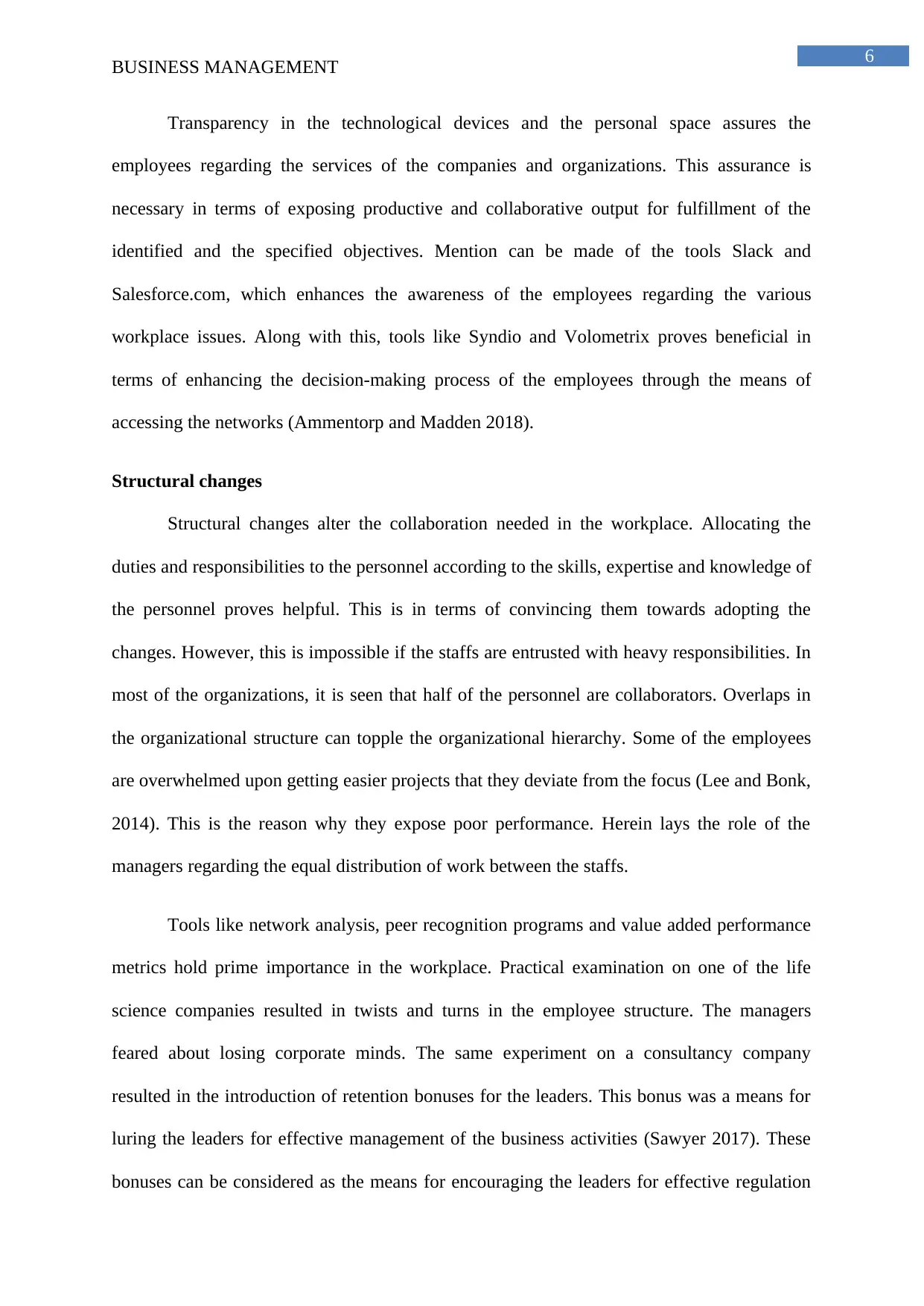
6
BUSINESS MANAGEMENT
Transparency in the technological devices and the personal space assures the
employees regarding the services of the companies and organizations. This assurance is
necessary in terms of exposing productive and collaborative output for fulfillment of the
identified and the specified objectives. Mention can be made of the tools Slack and
Salesforce.com, which enhances the awareness of the employees regarding the various
workplace issues. Along with this, tools like Syndio and Volometrix proves beneficial in
terms of enhancing the decision-making process of the employees through the means of
accessing the networks (Ammentorp and Madden 2018).
Structural changes
Structural changes alter the collaboration needed in the workplace. Allocating the
duties and responsibilities to the personnel according to the skills, expertise and knowledge of
the personnel proves helpful. This is in terms of convincing them towards adopting the
changes. However, this is impossible if the staffs are entrusted with heavy responsibilities. In
most of the organizations, it is seen that half of the personnel are collaborators. Overlaps in
the organizational structure can topple the organizational hierarchy. Some of the employees
are overwhelmed upon getting easier projects that they deviate from the focus (Lee and Bonk,
2014). This is the reason why they expose poor performance. Herein lays the role of the
managers regarding the equal distribution of work between the staffs.
Tools like network analysis, peer recognition programs and value added performance
metrics hold prime importance in the workplace. Practical examination on one of the life
science companies resulted in twists and turns in the employee structure. The managers
feared about losing corporate minds. The same experiment on a consultancy company
resulted in the introduction of retention bonuses for the leaders. This bonus was a means for
luring the leaders for effective management of the business activities (Sawyer 2017). These
bonuses can be considered as the means for encouraging the leaders for effective regulation
BUSINESS MANAGEMENT
Transparency in the technological devices and the personal space assures the
employees regarding the services of the companies and organizations. This assurance is
necessary in terms of exposing productive and collaborative output for fulfillment of the
identified and the specified objectives. Mention can be made of the tools Slack and
Salesforce.com, which enhances the awareness of the employees regarding the various
workplace issues. Along with this, tools like Syndio and Volometrix proves beneficial in
terms of enhancing the decision-making process of the employees through the means of
accessing the networks (Ammentorp and Madden 2018).
Structural changes
Structural changes alter the collaboration needed in the workplace. Allocating the
duties and responsibilities to the personnel according to the skills, expertise and knowledge of
the personnel proves helpful. This is in terms of convincing them towards adopting the
changes. However, this is impossible if the staffs are entrusted with heavy responsibilities. In
most of the organizations, it is seen that half of the personnel are collaborators. Overlaps in
the organizational structure can topple the organizational hierarchy. Some of the employees
are overwhelmed upon getting easier projects that they deviate from the focus (Lee and Bonk,
2014). This is the reason why they expose poor performance. Herein lays the role of the
managers regarding the equal distribution of work between the staffs.
Tools like network analysis, peer recognition programs and value added performance
metrics hold prime importance in the workplace. Practical examination on one of the life
science companies resulted in twists and turns in the employee structure. The managers
feared about losing corporate minds. The same experiment on a consultancy company
resulted in the introduction of retention bonuses for the leaders. This bonus was a means for
luring the leaders for effective management of the business activities (Sawyer 2017). These
bonuses can be considered as the means for encouraging the leaders for effective regulation
Paraphrase This Document
Need a fresh take? Get an instant paraphrase of this document with our AI Paraphraser
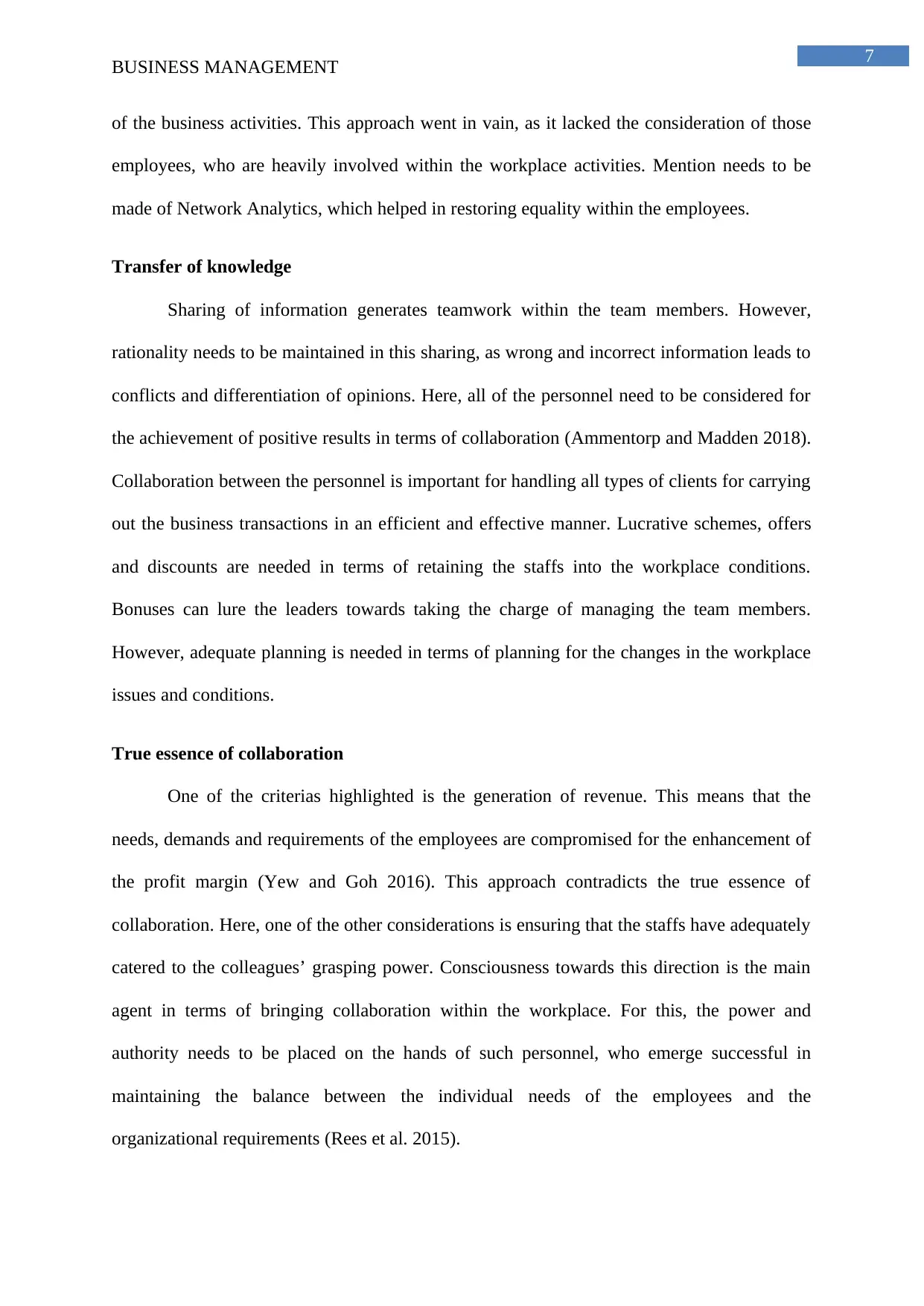
7
BUSINESS MANAGEMENT
of the business activities. This approach went in vain, as it lacked the consideration of those
employees, who are heavily involved within the workplace activities. Mention needs to be
made of Network Analytics, which helped in restoring equality within the employees.
Transfer of knowledge
Sharing of information generates teamwork within the team members. However,
rationality needs to be maintained in this sharing, as wrong and incorrect information leads to
conflicts and differentiation of opinions. Here, all of the personnel need to be considered for
the achievement of positive results in terms of collaboration (Ammentorp and Madden 2018).
Collaboration between the personnel is important for handling all types of clients for carrying
out the business transactions in an efficient and effective manner. Lucrative schemes, offers
and discounts are needed in terms of retaining the staffs into the workplace conditions.
Bonuses can lure the leaders towards taking the charge of managing the team members.
However, adequate planning is needed in terms of planning for the changes in the workplace
issues and conditions.
True essence of collaboration
One of the criterias highlighted is the generation of revenue. This means that the
needs, demands and requirements of the employees are compromised for the enhancement of
the profit margin (Yew and Goh 2016). This approach contradicts the true essence of
collaboration. Here, one of the other considerations is ensuring that the staffs have adequately
catered to the colleagues’ grasping power. Consciousness towards this direction is the main
agent in terms of bringing collaboration within the workplace. For this, the power and
authority needs to be placed on the hands of such personnel, who emerge successful in
maintaining the balance between the individual needs of the employees and the
organizational requirements (Rees et al. 2015).
BUSINESS MANAGEMENT
of the business activities. This approach went in vain, as it lacked the consideration of those
employees, who are heavily involved within the workplace activities. Mention needs to be
made of Network Analytics, which helped in restoring equality within the employees.
Transfer of knowledge
Sharing of information generates teamwork within the team members. However,
rationality needs to be maintained in this sharing, as wrong and incorrect information leads to
conflicts and differentiation of opinions. Here, all of the personnel need to be considered for
the achievement of positive results in terms of collaboration (Ammentorp and Madden 2018).
Collaboration between the personnel is important for handling all types of clients for carrying
out the business transactions in an efficient and effective manner. Lucrative schemes, offers
and discounts are needed in terms of retaining the staffs into the workplace conditions.
Bonuses can lure the leaders towards taking the charge of managing the team members.
However, adequate planning is needed in terms of planning for the changes in the workplace
issues and conditions.
True essence of collaboration
One of the criterias highlighted is the generation of revenue. This means that the
needs, demands and requirements of the employees are compromised for the enhancement of
the profit margin (Yew and Goh 2016). This approach contradicts the true essence of
collaboration. Here, one of the other considerations is ensuring that the staffs have adequately
catered to the colleagues’ grasping power. Consciousness towards this direction is the main
agent in terms of bringing collaboration within the workplace. For this, the power and
authority needs to be placed on the hands of such personnel, who emerge successful in
maintaining the balance between the individual needs of the employees and the
organizational requirements (Rees et al. 2015).
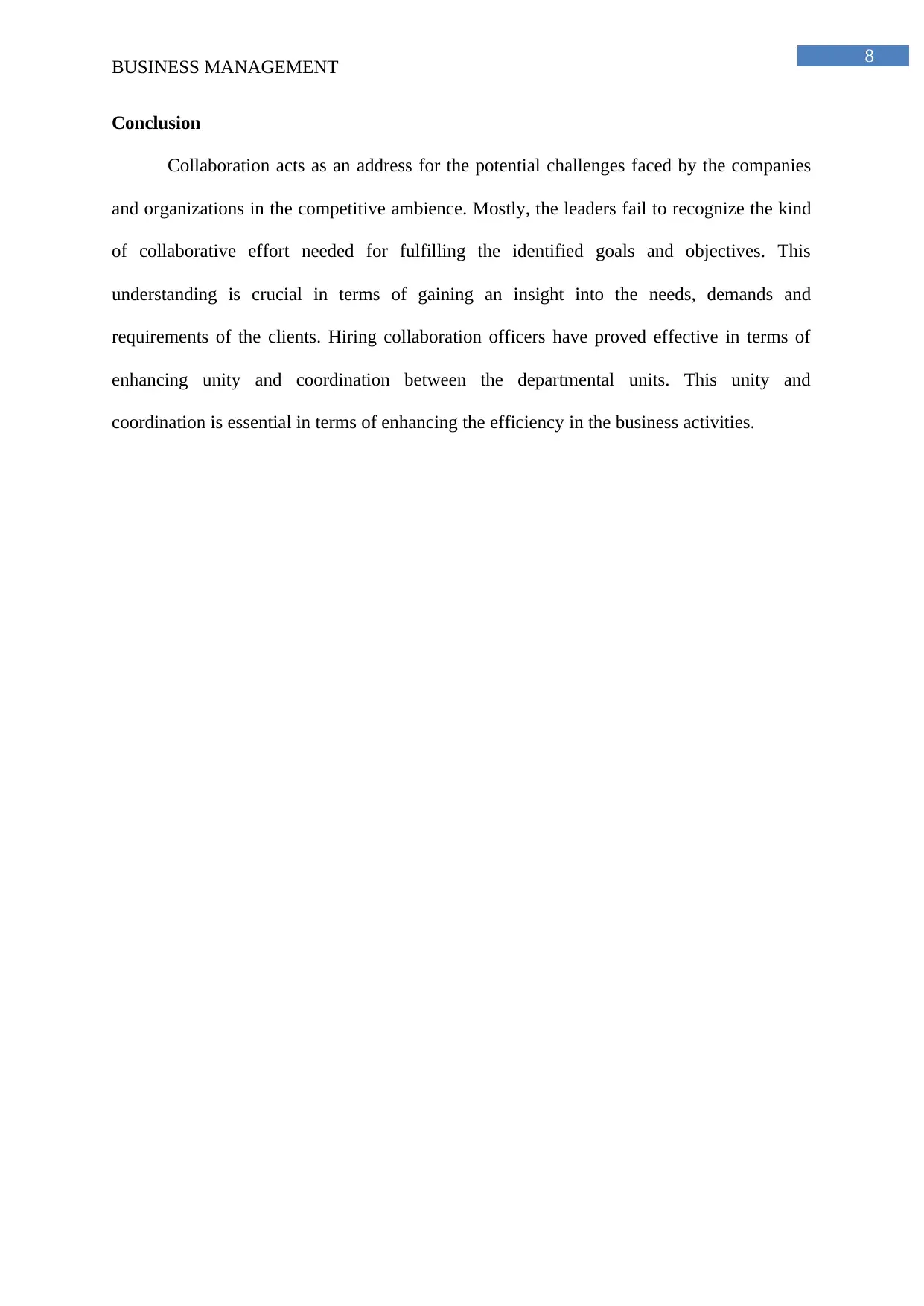
8
BUSINESS MANAGEMENT
Conclusion
Collaboration acts as an address for the potential challenges faced by the companies
and organizations in the competitive ambience. Mostly, the leaders fail to recognize the kind
of collaborative effort needed for fulfilling the identified goals and objectives. This
understanding is crucial in terms of gaining an insight into the needs, demands and
requirements of the clients. Hiring collaboration officers have proved effective in terms of
enhancing unity and coordination between the departmental units. This unity and
coordination is essential in terms of enhancing the efficiency in the business activities.
BUSINESS MANAGEMENT
Conclusion
Collaboration acts as an address for the potential challenges faced by the companies
and organizations in the competitive ambience. Mostly, the leaders fail to recognize the kind
of collaborative effort needed for fulfilling the identified goals and objectives. This
understanding is crucial in terms of gaining an insight into the needs, demands and
requirements of the clients. Hiring collaboration officers have proved effective in terms of
enhancing unity and coordination between the departmental units. This unity and
coordination is essential in terms of enhancing the efficiency in the business activities.
⊘ This is a preview!⊘
Do you want full access?
Subscribe today to unlock all pages.

Trusted by 1+ million students worldwide
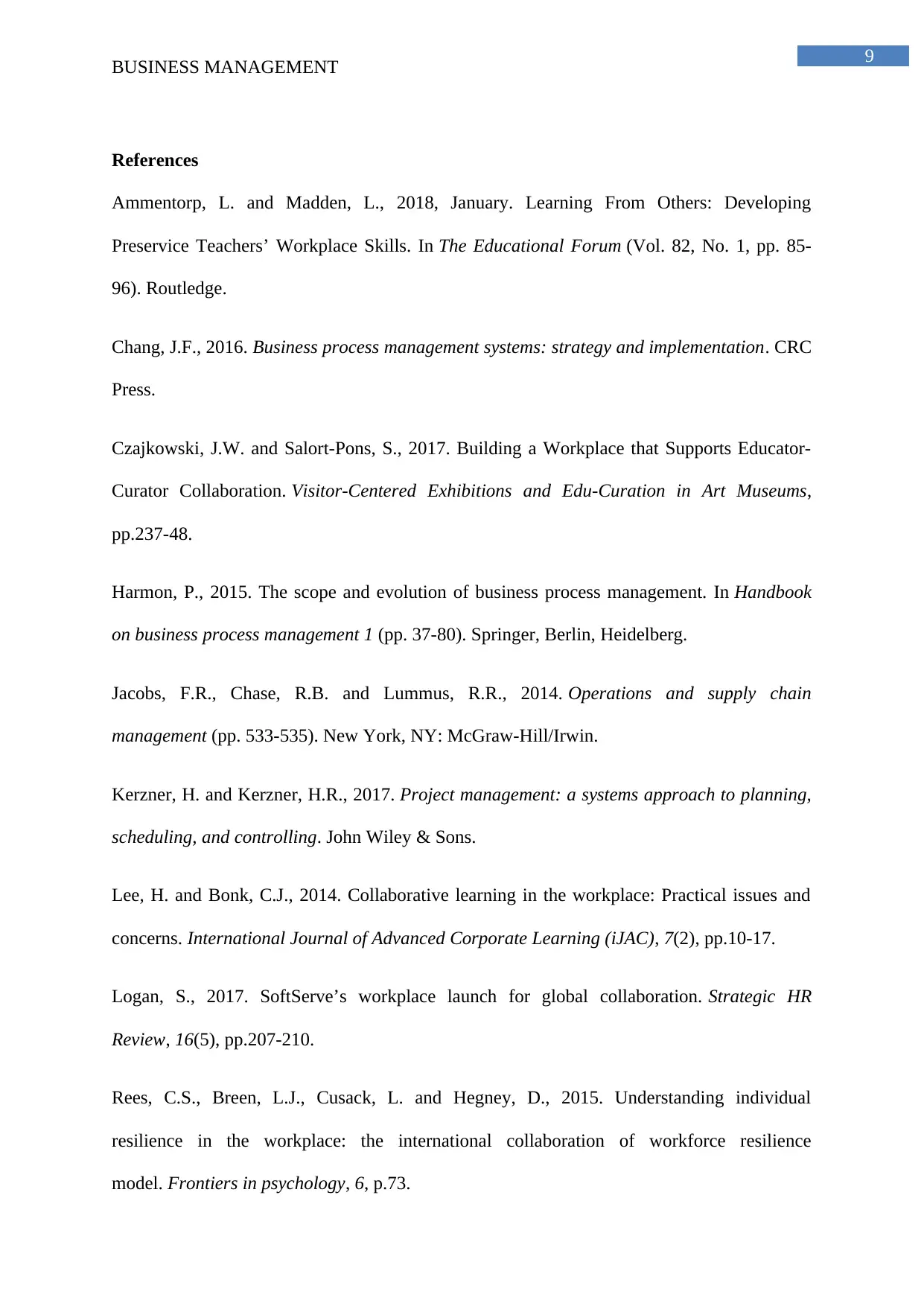
9
BUSINESS MANAGEMENT
References
Ammentorp, L. and Madden, L., 2018, January. Learning From Others: Developing
Preservice Teachers’ Workplace Skills. In The Educational Forum (Vol. 82, No. 1, pp. 85-
96). Routledge.
Chang, J.F., 2016. Business process management systems: strategy and implementation. CRC
Press.
Czajkowski, J.W. and Salort-Pons, S., 2017. Building a Workplace that Supports Educator-
Curator Collaboration. Visitor-Centered Exhibitions and Edu-Curation in Art Museums,
pp.237-48.
Harmon, P., 2015. The scope and evolution of business process management. In Handbook
on business process management 1 (pp. 37-80). Springer, Berlin, Heidelberg.
Jacobs, F.R., Chase, R.B. and Lummus, R.R., 2014. Operations and supply chain
management (pp. 533-535). New York, NY: McGraw-Hill/Irwin.
Kerzner, H. and Kerzner, H.R., 2017. Project management: a systems approach to planning,
scheduling, and controlling. John Wiley & Sons.
Lee, H. and Bonk, C.J., 2014. Collaborative learning in the workplace: Practical issues and
concerns. International Journal of Advanced Corporate Learning (iJAC), 7(2), pp.10-17.
Logan, S., 2017. SoftServe’s workplace launch for global collaboration. Strategic HR
Review, 16(5), pp.207-210.
Rees, C.S., Breen, L.J., Cusack, L. and Hegney, D., 2015. Understanding individual
resilience in the workplace: the international collaboration of workforce resilience
model. Frontiers in psychology, 6, p.73.
BUSINESS MANAGEMENT
References
Ammentorp, L. and Madden, L., 2018, January. Learning From Others: Developing
Preservice Teachers’ Workplace Skills. In The Educational Forum (Vol. 82, No. 1, pp. 85-
96). Routledge.
Chang, J.F., 2016. Business process management systems: strategy and implementation. CRC
Press.
Czajkowski, J.W. and Salort-Pons, S., 2017. Building a Workplace that Supports Educator-
Curator Collaboration. Visitor-Centered Exhibitions and Edu-Curation in Art Museums,
pp.237-48.
Harmon, P., 2015. The scope and evolution of business process management. In Handbook
on business process management 1 (pp. 37-80). Springer, Berlin, Heidelberg.
Jacobs, F.R., Chase, R.B. and Lummus, R.R., 2014. Operations and supply chain
management (pp. 533-535). New York, NY: McGraw-Hill/Irwin.
Kerzner, H. and Kerzner, H.R., 2017. Project management: a systems approach to planning,
scheduling, and controlling. John Wiley & Sons.
Lee, H. and Bonk, C.J., 2014. Collaborative learning in the workplace: Practical issues and
concerns. International Journal of Advanced Corporate Learning (iJAC), 7(2), pp.10-17.
Logan, S., 2017. SoftServe’s workplace launch for global collaboration. Strategic HR
Review, 16(5), pp.207-210.
Rees, C.S., Breen, L.J., Cusack, L. and Hegney, D., 2015. Understanding individual
resilience in the workplace: the international collaboration of workforce resilience
model. Frontiers in psychology, 6, p.73.
Paraphrase This Document
Need a fresh take? Get an instant paraphrase of this document with our AI Paraphraser
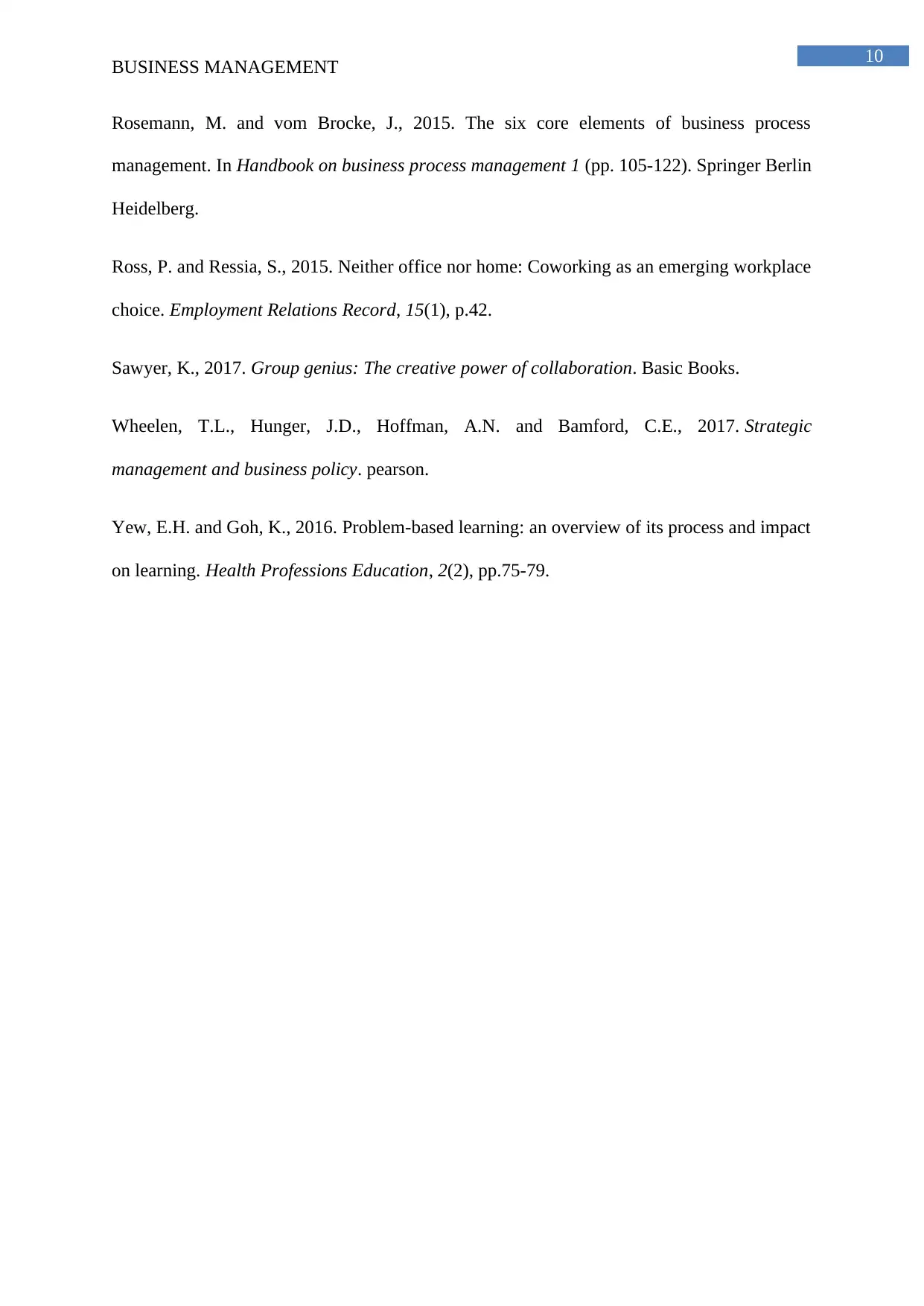
10
BUSINESS MANAGEMENT
Rosemann, M. and vom Brocke, J., 2015. The six core elements of business process
management. In Handbook on business process management 1 (pp. 105-122). Springer Berlin
Heidelberg.
Ross, P. and Ressia, S., 2015. Neither office nor home: Coworking as an emerging workplace
choice. Employment Relations Record, 15(1), p.42.
Sawyer, K., 2017. Group genius: The creative power of collaboration. Basic Books.
Wheelen, T.L., Hunger, J.D., Hoffman, A.N. and Bamford, C.E., 2017. Strategic
management and business policy. pearson.
Yew, E.H. and Goh, K., 2016. Problem-based learning: an overview of its process and impact
on learning. Health Professions Education, 2(2), pp.75-79.
BUSINESS MANAGEMENT
Rosemann, M. and vom Brocke, J., 2015. The six core elements of business process
management. In Handbook on business process management 1 (pp. 105-122). Springer Berlin
Heidelberg.
Ross, P. and Ressia, S., 2015. Neither office nor home: Coworking as an emerging workplace
choice. Employment Relations Record, 15(1), p.42.
Sawyer, K., 2017. Group genius: The creative power of collaboration. Basic Books.
Wheelen, T.L., Hunger, J.D., Hoffman, A.N. and Bamford, C.E., 2017. Strategic
management and business policy. pearson.
Yew, E.H. and Goh, K., 2016. Problem-based learning: an overview of its process and impact
on learning. Health Professions Education, 2(2), pp.75-79.
1 out of 11
Related Documents
Your All-in-One AI-Powered Toolkit for Academic Success.
+13062052269
info@desklib.com
Available 24*7 on WhatsApp / Email
![[object Object]](/_next/static/media/star-bottom.7253800d.svg)
Unlock your academic potential
Copyright © 2020–2025 A2Z Services. All Rights Reserved. Developed and managed by ZUCOL.





